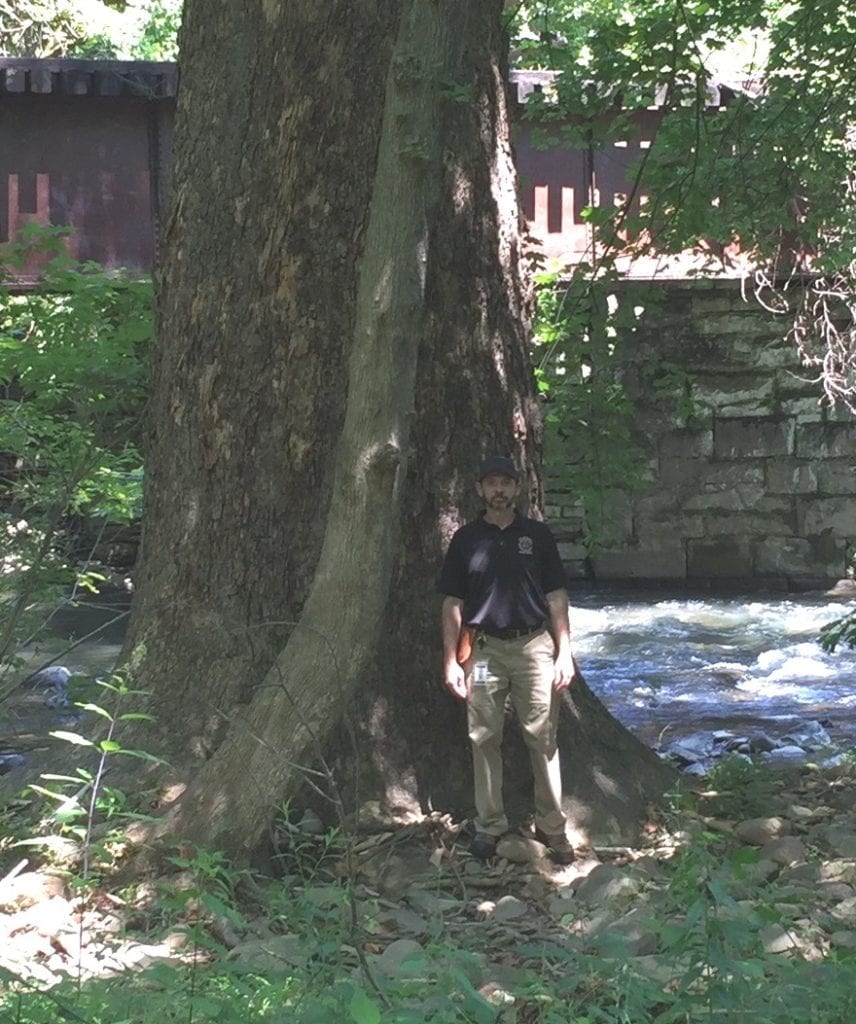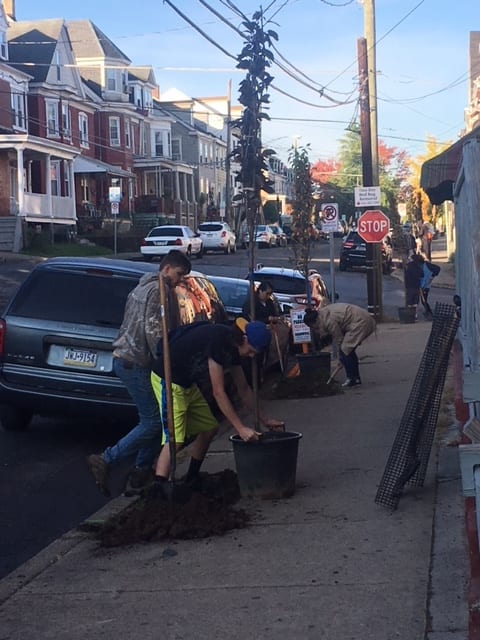Four years ago, Rob Christopher took on the role of full-time Urban Forester for the city of Easton, a position that had not been filled since the 1980s. Since then, he has had a hand in planting over 800 trees on city streets, in parks, and along our trails. Rob is committed to sharing the message of trees’ benefits with residents throughout the city and working with volunteer groups, homeowners, and community partners to continue greening Easton.
Trees sequester carbon dioxide, collect pollution particulates, prevent massive stormwater runoff, support wildlife populations, and provide cooling effects that help to mitigate the urban heat island effects in our neighborhoods. Rob explains that trees’ value extends far beyond these measurable contributions – “Of course I’m a huge advocate of trees and I know what all the benefits are, and to me it’s so much more than scientific. Once we get into the psychological, emotional part of this, people remember as kids, trees on their properties. In cities we have so few trees and places to plant them, so when they are out on sidewalks they’re a place for people to meet, to talk, to sit in the shade in the summer if they don’t have air conditioning. To really even just sit there and be inspired by the tree itself and the birds that are hanging out in there and the wildlife. There’s just so much that a tree is giving back to us.” In addition, he says, nearby trees can increase property values by as much as 15% – nicely shaded streets with mature trees are desirable places to live.
To be successful in his work, Rob has to be able to describe all of these benefits to homeowners who may be wary of planting a tree on their property, perhaps concerned it will disturb the sidewalk or damage underground water or sewer lines. Increasingly, he is finding that these are concerns of the past as trees that are well-suited to planting in sidewalks take the place of species like Norway maple, Bradford pear, and honey locust – trees that were previously in widespread use and sometimes caused issues in urban settings. “We are getting people past these horrible introductions to trees. These new trees are meant specifically for the urban environment.” Rob explains. This means that they grow in a more columnar structure, so as to not interfere with parking or buildings, and have smaller root flares that don’t disrupt sidewalks. He has also worked to change the shade tree ordinance code to ensure that large canopy trees can only be planted where they will have enough space – at least 16 square feet in area. He describes the trees planted 30, 40, or 50 years ago, often in less than ideal locations, as experiments that inform what he does today to maximize the benefits of our street trees.
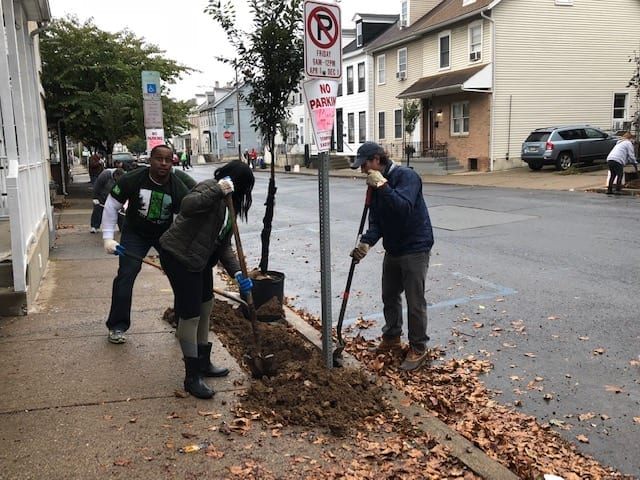
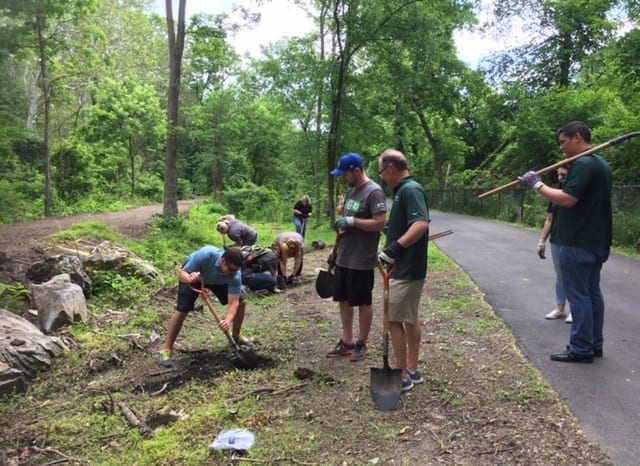
Volunteers help Rob with tree plantings throughout the city.
In addition to selecting the right tree for the right location, this work includes caring for young trees for at least 3 years after they are first planted. Trees are planted with fertilizer and an application of mycorrhizae – a fungus that forms a symbiotic relationship with the plant’s roots and helps it to absorb water and nutrients. This year, Rob will also add an organic liquid fertilizer to the water tank on his truck to continue delivering nutrients to the trees when he waters them. The newly planted trees are protected with trunk guards and Gator bags, which can hold water and distribute it over several hours. Trees with less developed root systems are also staked. “You can’t just plant a tree and forget about it, they really need a lot of help the first year,” Rob explains. He prunes small trees, until they get too big to prune without climbing, at which point homeowners take the reins to care for the trees on their property. From the time of planting, it may be 5 or 6 years before a homeowner has to spend any money maintaining their tree, largely because of the major role Rob plays in maintaining Easton’s greenery in the interim!
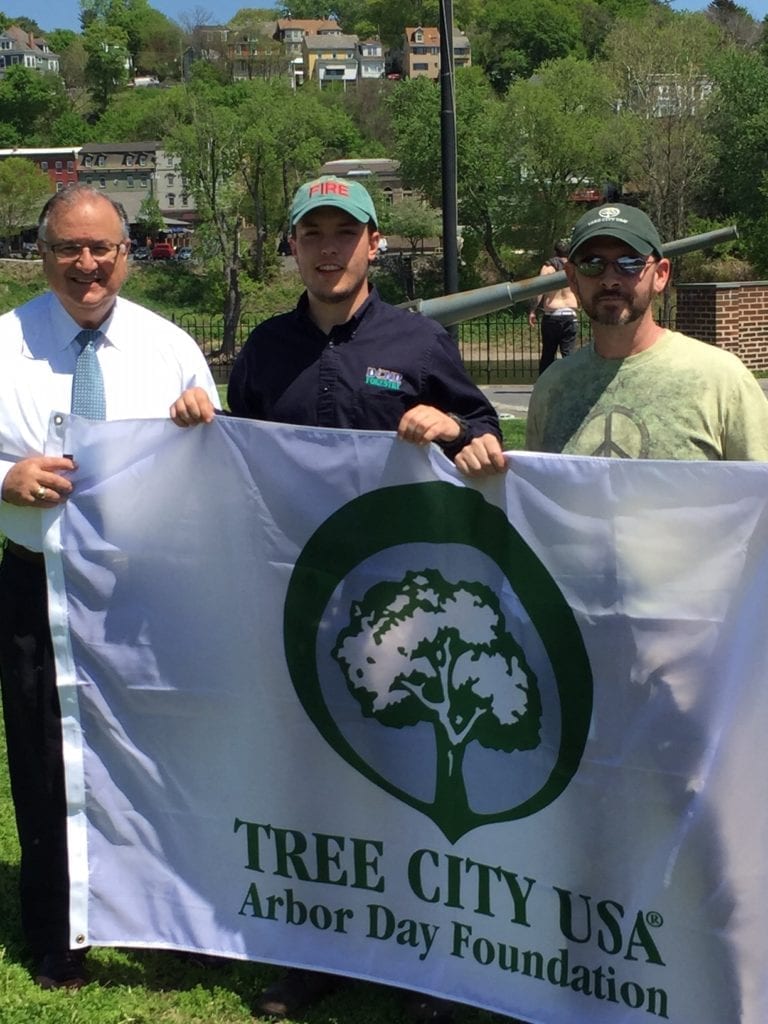 To support both the logistics of tree planting and public education efforts, Rob worked to obtain a grant through the Arbor Day Foundation to plant a micro-forest at Lower Hackett Park and will also establish a nursery at the park with the Public Works department to maintain an inventory of trees and shrubs at a central location during planting efforts. The micro-forest will contain the multiple levels of a natural forest – with herbaceous plants covering the forest floor, shrubs and smaller trees making up the understory, and larger trees creating the canopy. This project is a true community effort, funded through the Enterprise Holdings Co. and involving Rob, over 60 employees from Enterprise, local volunteers, and 2 Parks Department employees in the installation effort.
To support both the logistics of tree planting and public education efforts, Rob worked to obtain a grant through the Arbor Day Foundation to plant a micro-forest at Lower Hackett Park and will also establish a nursery at the park with the Public Works department to maintain an inventory of trees and shrubs at a central location during planting efforts. The micro-forest will contain the multiple levels of a natural forest – with herbaceous plants covering the forest floor, shrubs and smaller trees making up the understory, and larger trees creating the canopy. This project is a true community effort, funded through the Enterprise Holdings Co. and involving Rob, over 60 employees from Enterprise, local volunteers, and 2 Parks Department employees in the installation effort.
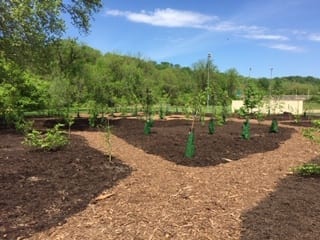
Some of the new trees at the Hackett Park installation
In addition, the park is home to a community garden installed by Greater Easton Development Partnership with help from the Parks Department. Moving forward, Rob hopes to add shelters to attract wildlife, such as bluebird houses and bat houses, and have flowering plants that will attract pollinators. There will be pathways for visitors to walk through the park and educational signage to help people learn about the natural systems that are present and how they can apply similar ideas to their own property. Once established, both the nursery and micro-forest will serve as outdoor education areas for youth. Rob hopes they would be able to help with potting and caring for saplings and learn about the importance of trees and forests early in life.
The city currently has in its database 4700-4800 trees it has planted in right-of-ways and parks. A 33-50% increase in this number is possible – and Rob is looking for your help in making it happen! “That is the most vital thing I need today – people who are reliable, passionate, and excited about helping green up their community,” he says. Some of Rob’s existing volunteers include Lafayette College students from environmental clubs and athletic teams and residents who connect through community groups such as the West Ward Initiative, Main Street Initiative, Easton Ambassadors, and others. Volunteers help not only with physical tree plantings but also educational and outreach tasks to change how people think about the role of trees in an urban setting. This April, Arbor Day, Earth Day, and Easton Cleanup Day will all present opportunities to get involved. Rob posts up to date information on the City of Easton, Urban Forestry Facebook page, including volunteer opportunities like these. “If there’s anyone in the community that is interested in being my shadow, learning from what I’ve learned – from a kid up until now I’ve been like a sponge and just taken everything in, and I think in the last 5 years I’ve learned more than everything that came before. I’d love to pass this on to someone else that has a passion about this,” Rob says.
When asked about his motivation and goals in doing this work, he looks to the future. “This is where we live. We can’t think about this as just right now. When I plant a tree on my property, I might know that I may not live to see this oak tree become mature, but what’s going on in my mind is, I can picture all these things that I planted, and I can see them on my property already mature… We have to think about the future and our kids and our grandkids – how are we going to leave where we live right now.”
Rob is certainly creating an Easton that is greener than he found it. That means an Easton that sequesters more carbon; has less air pollution; is better prepared to handle stormwater runoff; has more places for wildlife to live; has more shady spots in the summer; and gives residents more opportunities to connect with the plants that humans have gathered around, climbed, picked fruit from, painted and photographed, and sat under for generations – our trees.
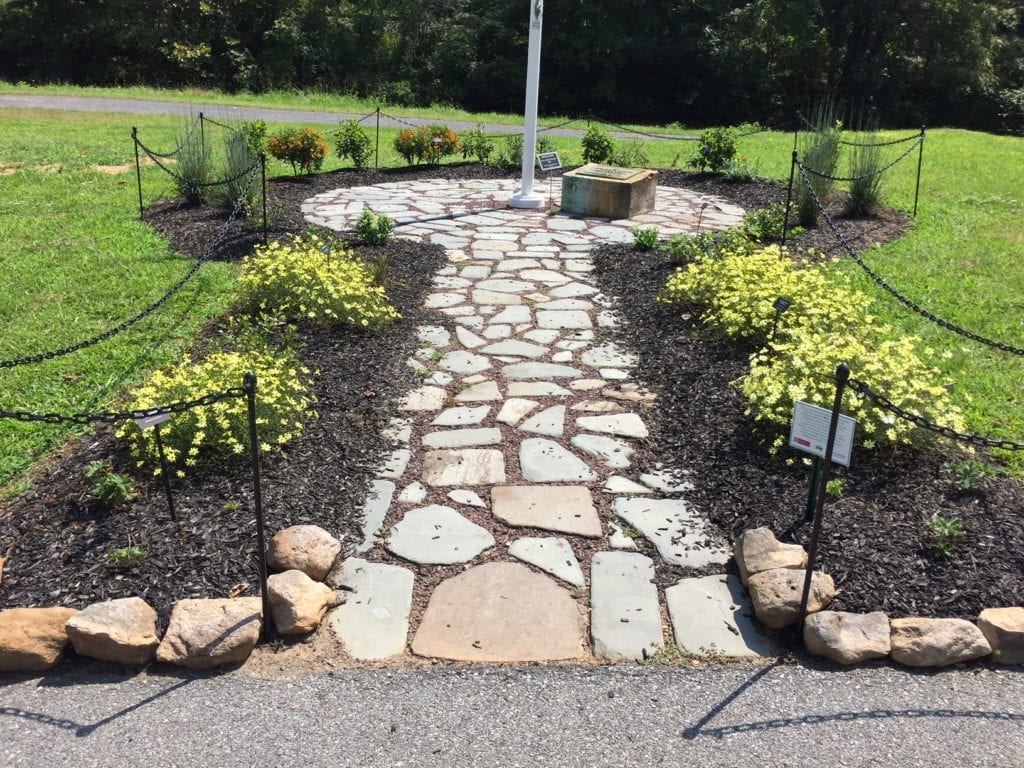
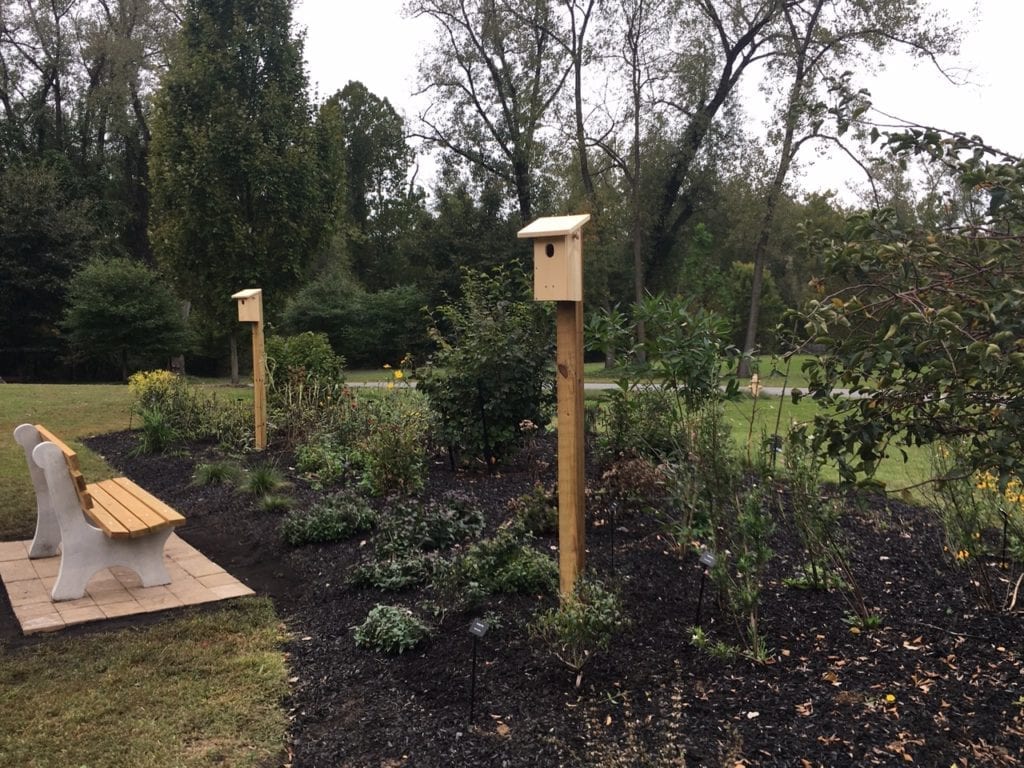
Native plants and bluebird houses at parks throughout the city
Send Rob a message here or contact him at (610) 250-6734.
Visit the City of Easton, Urban Forestry Facebook page for volunteer opportunities.
See https://www.easton-pa.com/public-works/pages/shade-trees for information on applying for the city’s free street trees program.
All photos courtesy of Rob Christopher.

